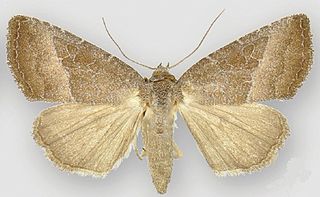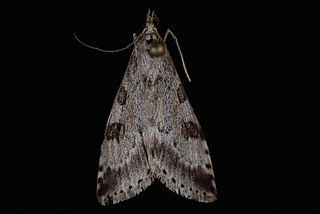
The Crambidae are the grass moth family of lepidopterans. They are variable in appearance, the nominal subfamily Crambinae taking up closely folded postures on grass stems where they are inconspicuous, while other subfamilies include brightly coloured and patterned insects which rest in wing-spread attitudes.

Mycalesis perseus, the dingy bushbrown or common bushbrown, is a species of satyrine butterfly found in south Asia and southeast Asia.

The Bird’s Wing(Dypterygia scabriuscula) is a moth of the family Noctuidae. The species can be found in Europe and the western Palearctic.

Helotropha leucostigma, the crescent, formerly Celaena leucostigma is a moth of the family Noctuidae. It is found in the Palearctic realm.
Microtheoris is a genus of moths of the family Crambidae.
Procymbopteryx is a monotypic moth genus of the family Crambidae erected by Eugene G. Munroe in 1961. Its only species, Procymbopteryx belialis, was first described by Herbert Druce in 1899. It is found in the Mexican state of Guerrero and the US state of Arizona.

Ogdoconta cinereola, the common pinkband moth, is a moth in the family Noctuidae. It is found in eastern, central, and south-western North America. It occurs from southern Ontario and Quebec south to southern Florida. At the western edge of its distribution, it occurs from Manitoba southward through the Great Plains of Nebraska and Iowa, south throughout most of Texas, and westward through southern New Mexico to south-eastern Arizona. The distribution extends south to the state of Coahuila in northern Mexico.

Protorthodes incincta, the banded Quaker moth, is a moth in the family Noctuidae. It is found in North America, where it has been recorded in the western Great Plains and dry open forests of the Rocky Mountain region, with range extensions into the Great Basin, the American Southwest, and eastward in relict prairie areas into the Great Lakes region.

Protorthodes mexicana is a moth in the family Noctuidae first described by J. Donald Lafontaine in 2014. It is found in Xalapa, Mexico.
Neodactria caliginosellus, the corn root webworm or black grass-veneer, is a moth in the family Crambidae. It was described by James Brackenridge Clemens in 1860. It is found in North America, where it has been recorded from Alabama, Alberta, California, Florida, Georgia, Illinois, Indiana, Maine, Maryland, Mississippi, North Carolina, Ohio, Oklahoma, Ontario, South Carolina and Tennessee. The habitat consists of grassy areas and fields.
Hellula kempae, or Kemp's hellula moth, is a moth in the family Crambidae. It was described by Eugene G. Munroe in 1972. It is found in North America, where it has been recorded from Alabama, Florida, Mississippi, South Carolina and Texas. It is also found in Cuba.

Ostrinia penitalis, the American lotus borer, is a moth in the family Crambidae. It was described by Augustus Radcliffe Grote in 1876. It is found from Mexico, through Central America to Amazonas, Brazil. It is also found in North America, where it has been recorded from Quebec to British Columbia and most of the United States. The habitat consists of marshes and pondsides.
Pyrausta socialis, the sociable pyrausta moth, is a moth in the family Crambidae. It was described by Augustus Radcliffe Grote in 1877. It is found in North America, where it has been recorded from Ontario west to British Columbia, south to Montana and Colorado.
Pyrausta subsequalis is a moth in the family Crambidae. It was described by Achille Guenée in 1854. It is found in North America, where it has been recorded from southern Alberta and southern British Columbia south to Arizona and New Mexico. The habitat consists of dry prairie areas.

Pyrausta unifascialis, the one-banded pyrausta, is a moth in the family Crambidae. It was described by Alpheus Spring Packard in 1873. It is found in North America, where it has been recorded from Quebec west to British Columbia, south to Arizona and California. The habitat consists of forest openings, clearings and fields.
Scoparia rigidalis is a moth in the family Crambidae. It was described by William Barnes and James Halliday McDunnough in 1912. It is found in North America, where it has been recorded from Arizona.
Microtheoris vibicalis, the whip-marked snout moth, is a moth in the family Crambidae. It was described by Zeller in 1873. It is found in North America, where it has been recorded from Kansas, New Mexico, Oklahoma and Texas.
Epipagis forsythae, or Forsyth's epipagis moth, is a moth in the family Crambidae. It was described by Eugene G. Munroe in 1955. It is found in North America, where it has been recorded from Florida.
Mecyna submedialis, the orange-toned mecyna moth, is a moth in the family Crambidae. It was described by Augustus Radcliffe Grote in 1876. It is found in North America, where it has been recorded from Ontario and Michigan, south to Florida and west to Arkansas. It has also been recorded from Alberta.

Udea washingtonalis, the Washington udea moth, is a moth in the family Crambidae. It was described by Augustus Radcliffe Grote in 1882. It is found in North America, where it has been recorded from Alaska, British Columbia, California, Montana and Washington.










